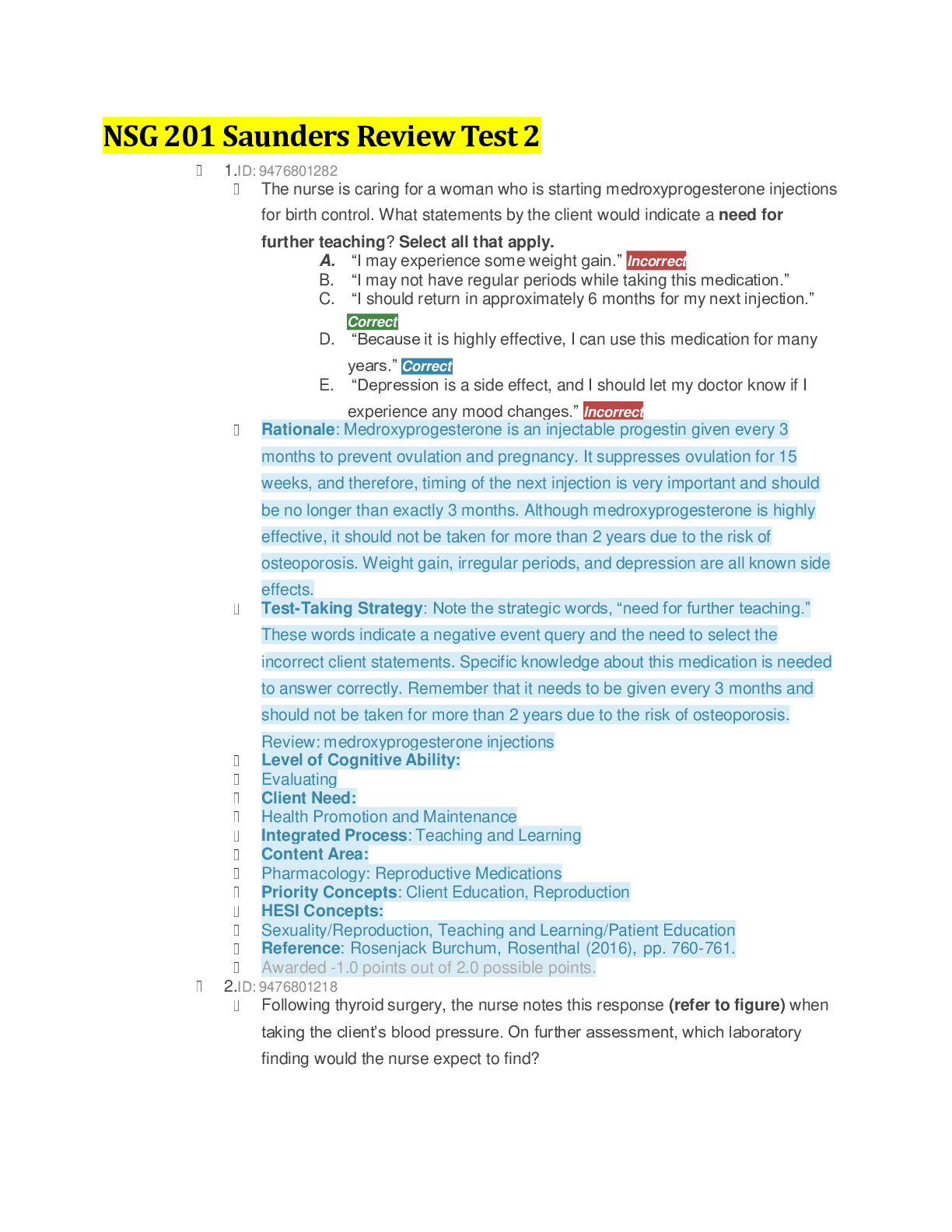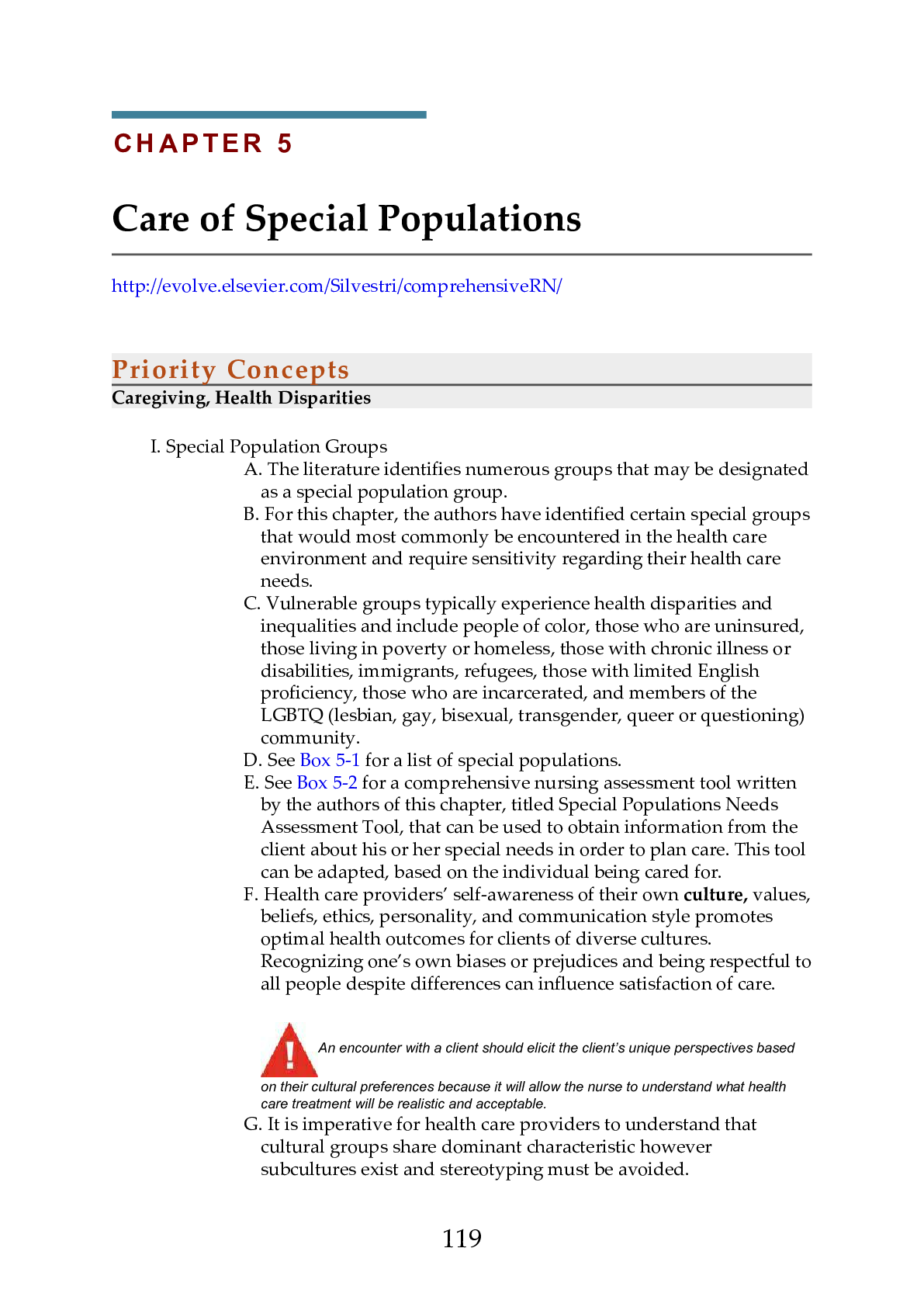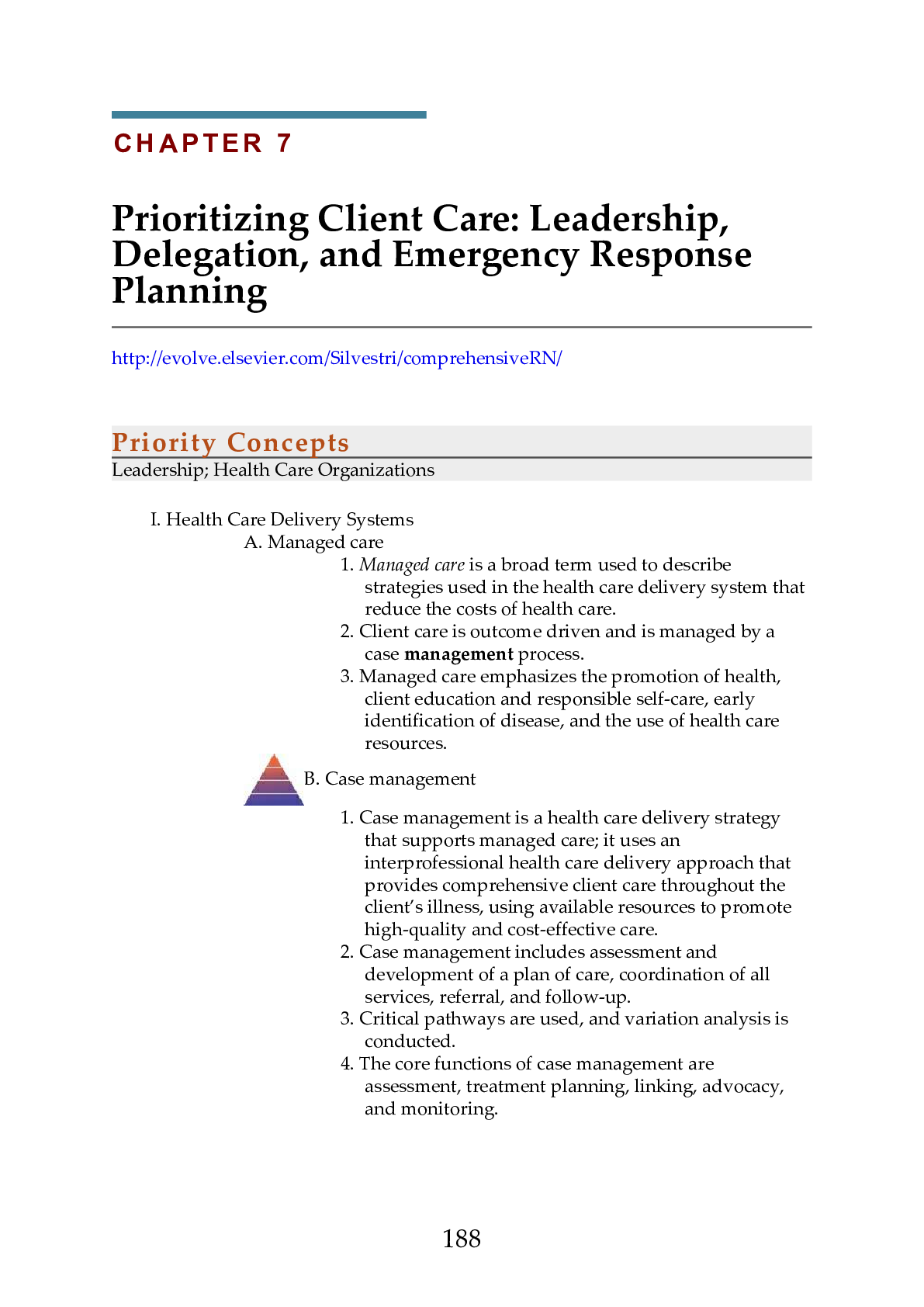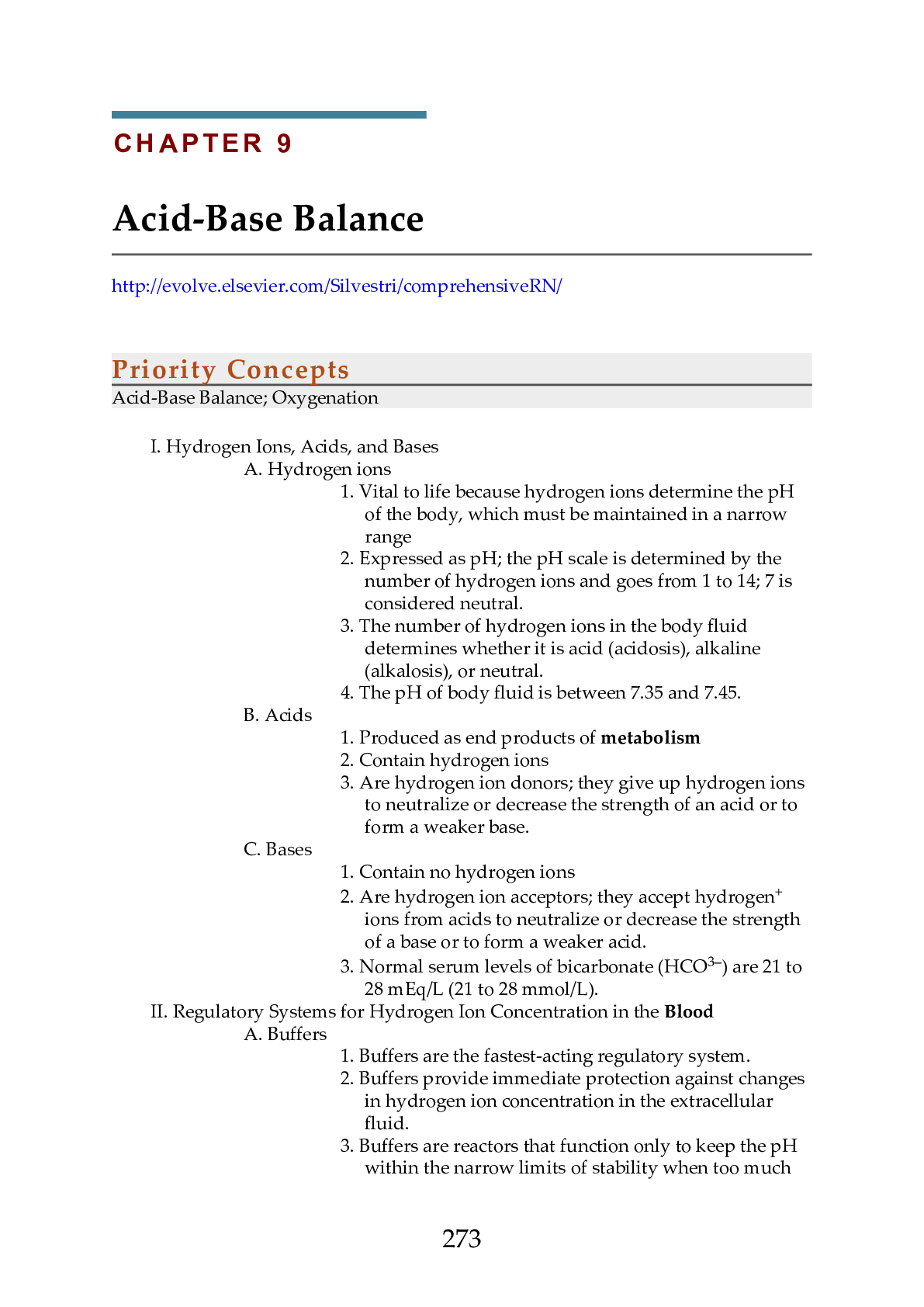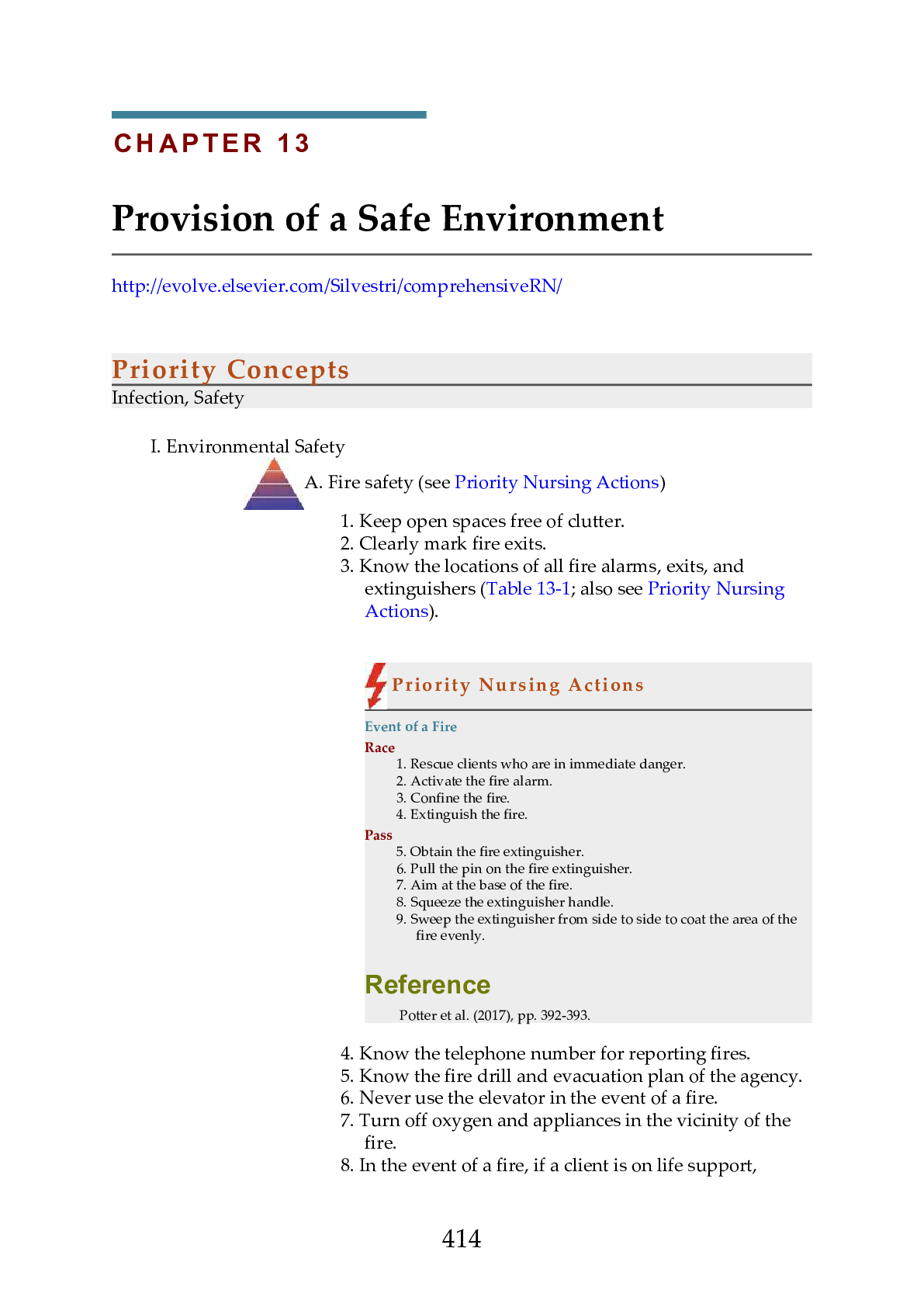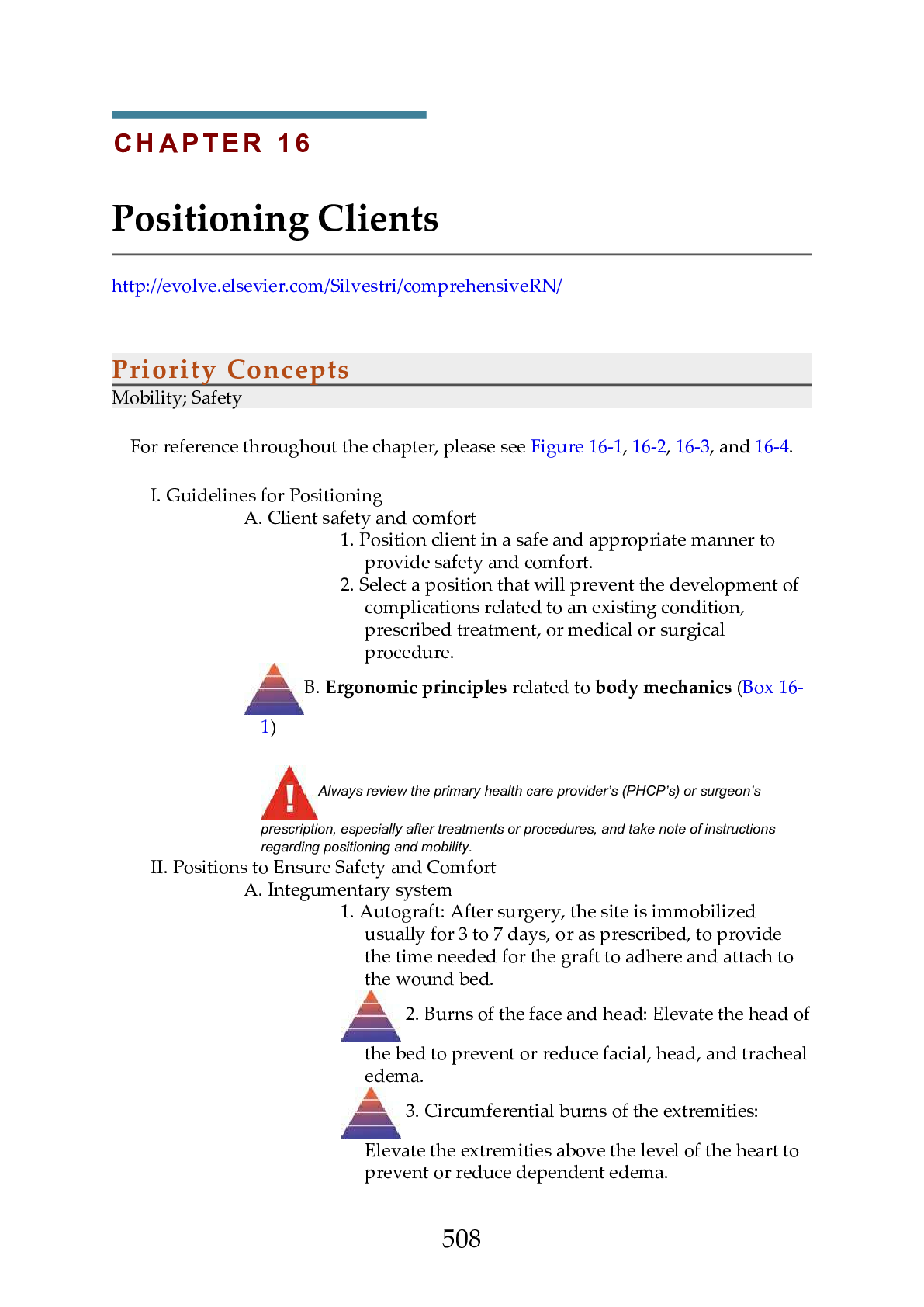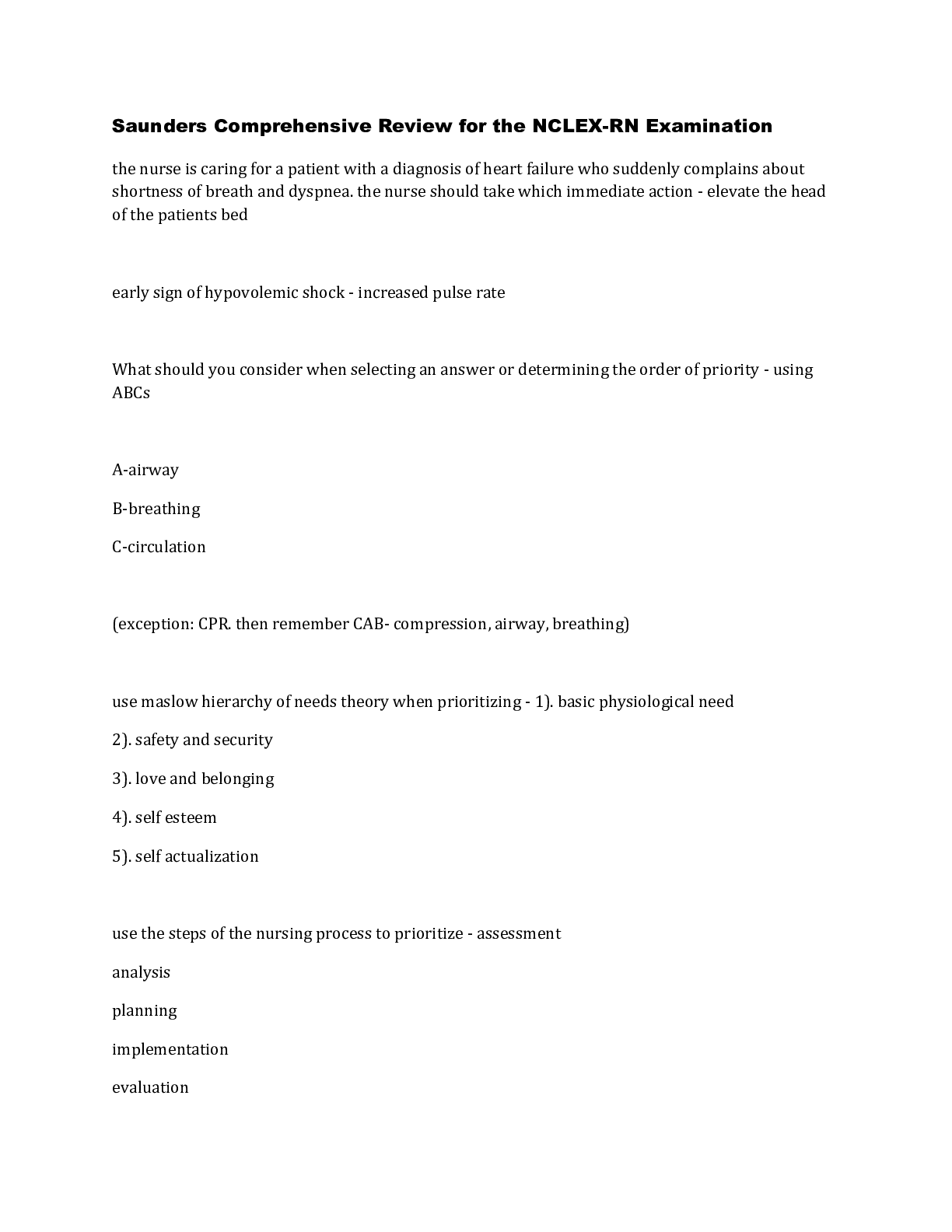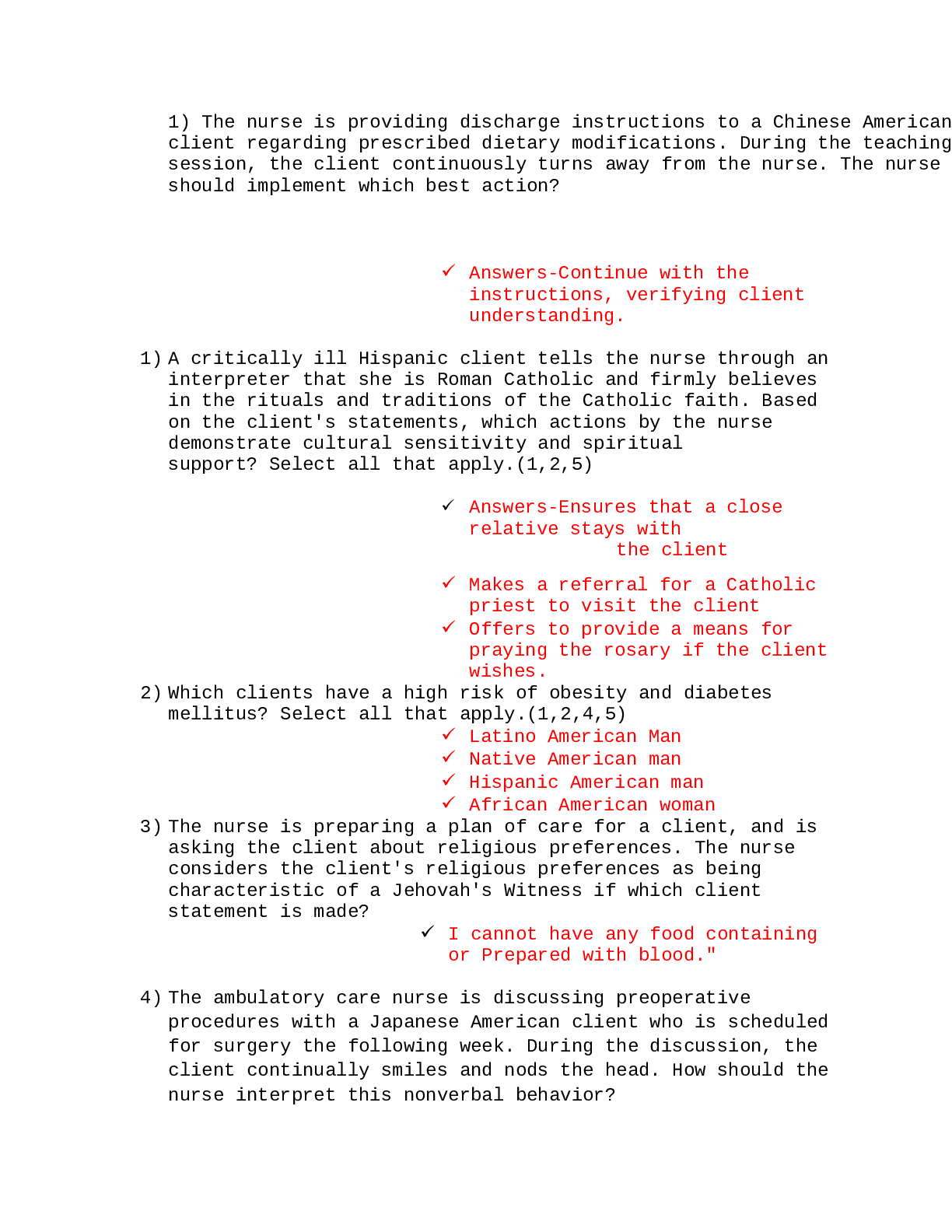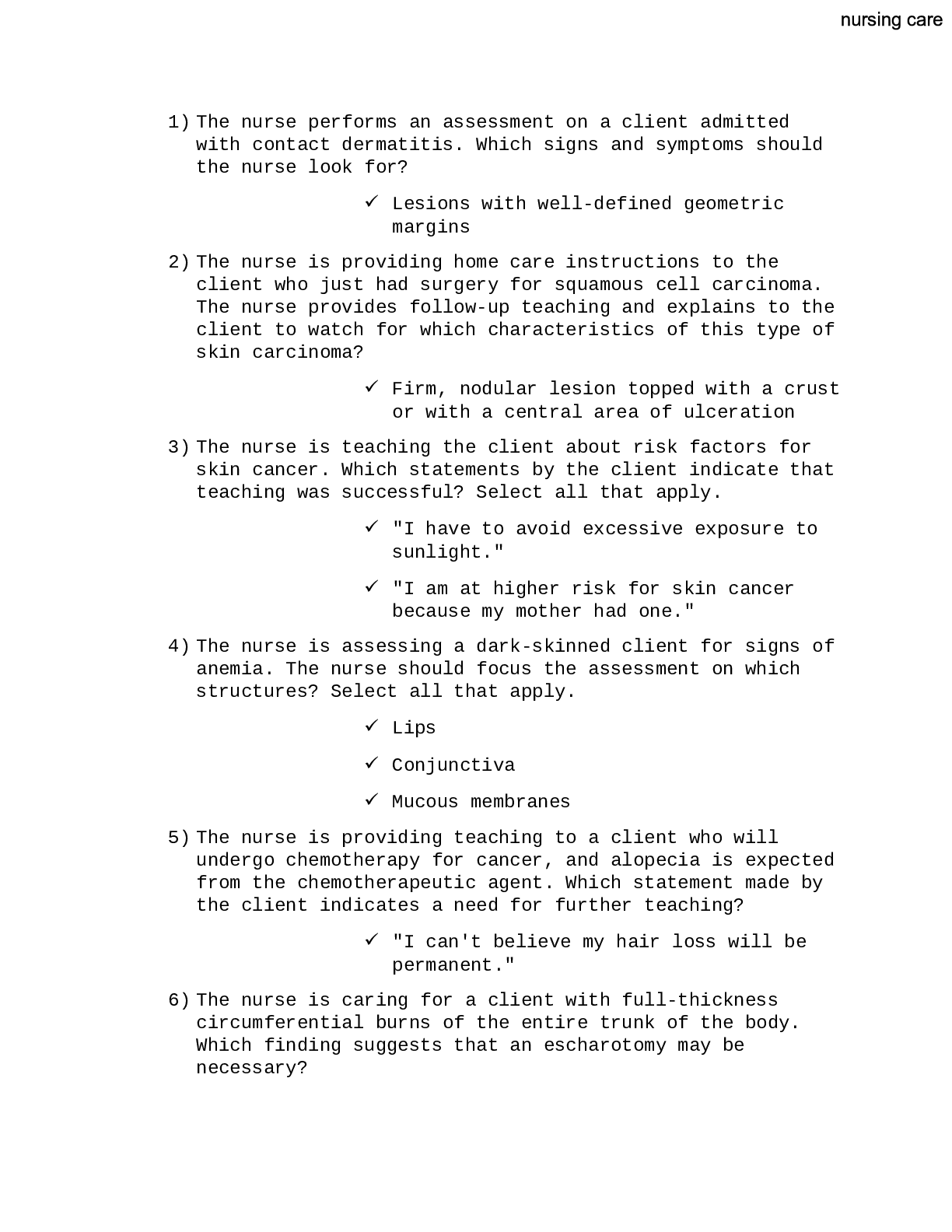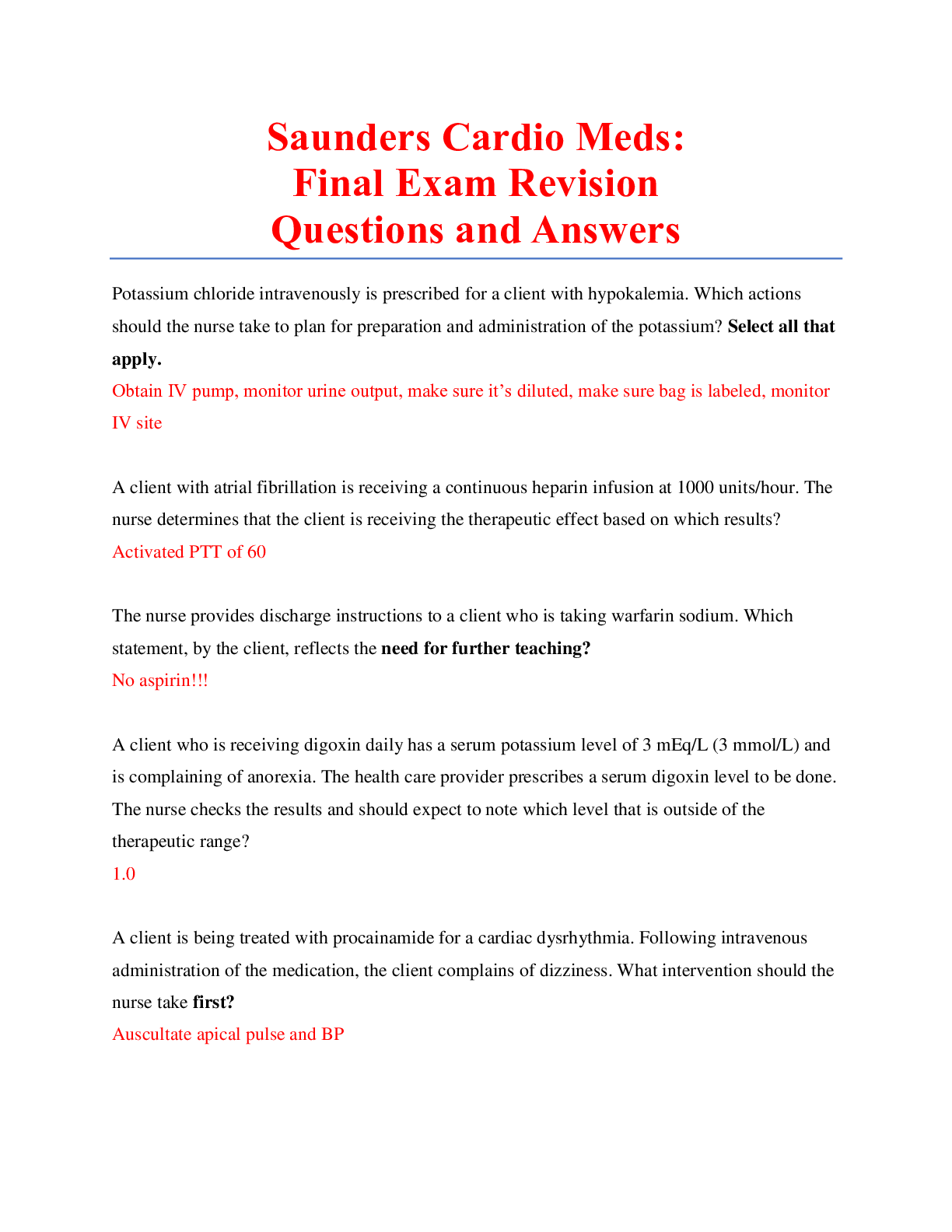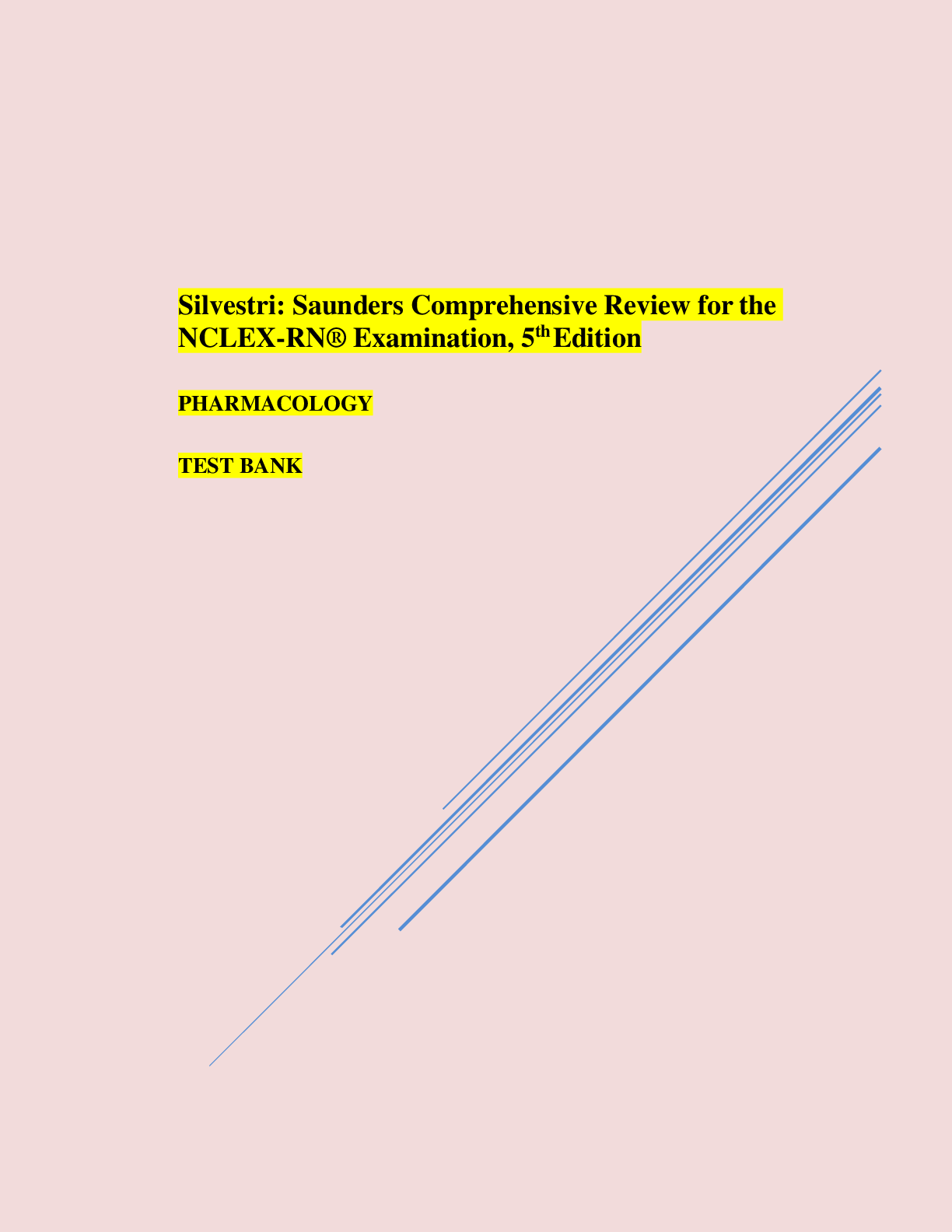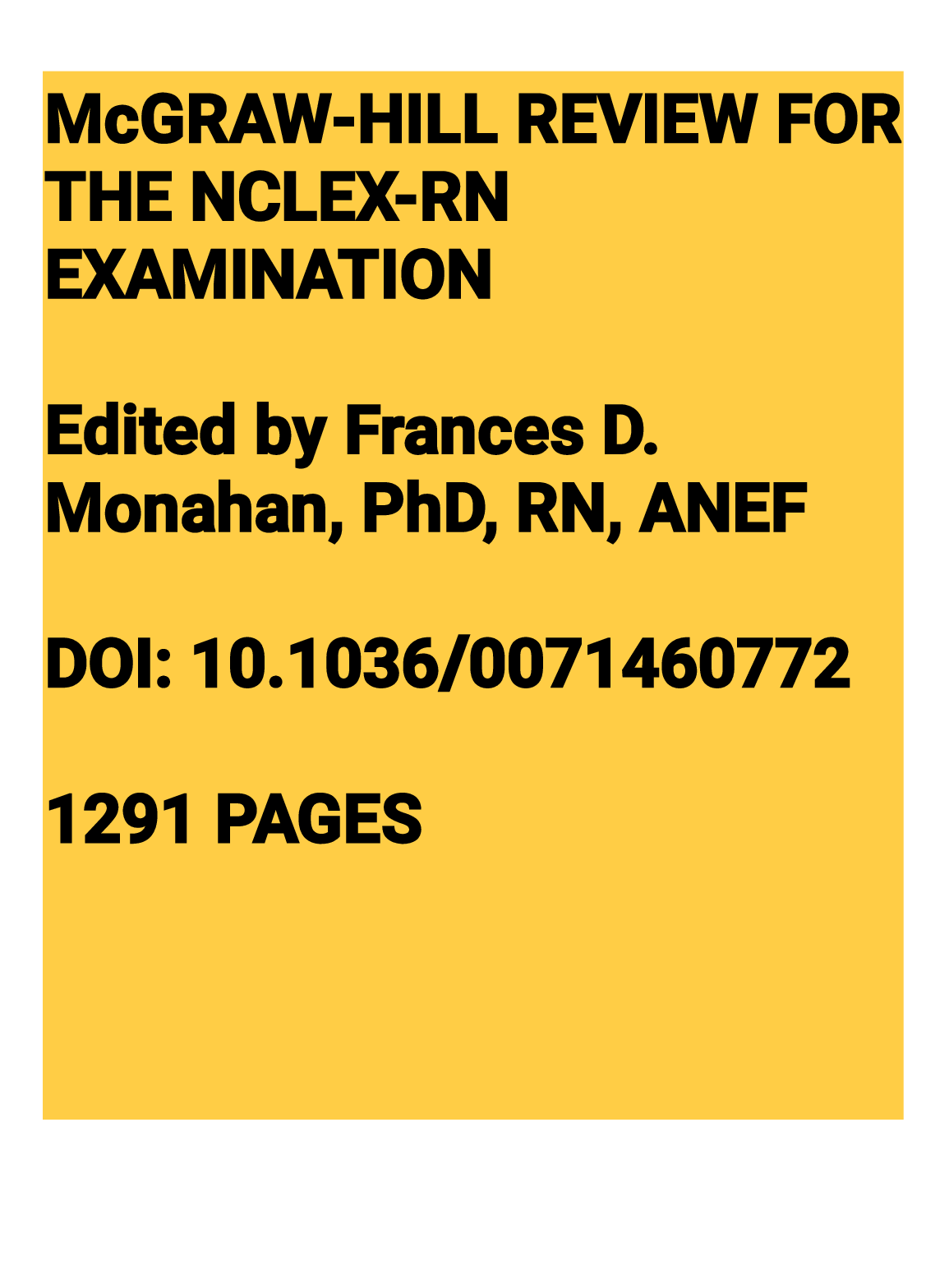*NURSING > NCLEX-RN > C H A P T E R 1 4 Calculation of Medication and Intravenous Prescriptions: From Saunders Comprehensi (All)
C H A P T E R 1 4 Calculation of Medication and Intravenous Prescriptions: From Saunders Comprehensive Review for the NCLEX-RN Examination 8th Edition. (Available: https://bit.ly/2HeJuMt ). Contains Practice questions and Answers with the Rationale, Test-Taking Strategy, Level of Cognitive Ability, Client Needs, Integrated Process, Content Area, Health Problem, Priority Concepts and Reference
Document Content and Description Below
Priority Concepts Clinical Judgment, Safety I. Medication Administration (Box 14-1) In most clinical settings, an electronic infusion device is used to administer intravenous (IV) solutions and IV... medications. However, the NCLEX-RN® examination is going to require that you correctly calculate an intravenous infusion rate via drops per minute, so be sure that you master this skill. II. Medication Measurement Systems A. Metric system (Box 14-2) 1. The basic units of metric measures are the meter, liter, and gram. 2. Meter measures length; liter measures volume; gram measures mass. B. Apothecary and household systems 1. The apothecary and household systems are the oldest of the medication measurement systems. 2. Apothecary measures such as grain, dram, and minim are not commonly used in the clinical setting. 3. Commonly used household measures include drop, teaspoon, tablespoon, ounce, pint, and cup. The NCLEX will not present questions that require you to convert from the apothecary system of measurement to the metric system; however, this system is still important to know because, although it is not commonly used, you may encounter it in the clinical setting. C. Additional common medication measures 1. Milliequivalent a. Milliequivalent is abbreviated mEq. b. The milliequivalent is an expression of the number of grams of a medication contained in 1 mL of a solution. c. For example, the measure of serum 442potassium is given in milliequivalents. 2. Unit a. Unit measures a medication in terms of its action, not its physical weight. b. For example, penicillin, heparin sodium, and insulin are measured in units. III. Conversions A. Conversion between metric units (Box 14-3) 1. The metric system is a decimal system; therefore, conversions between the units in this system can be done by dividing or multiplying by 1000 or by moving the decimal point 3 places to the right or 3 places to the left. 2. In the metric system, to convert larger to smaller, multiply by 1000 or move the decimal point 3 places to the right. 3. In the metric system, to convert smaller to larger, divide by 1000 or move the decimal point 3 places to the left. B. Conversion between household and metric systems 1. Household and metric measures are equivalent and not equal measures. 2. Conversion to equivalent measures between systems is necessary when a medication prescription is written in one system but the medication label is stated in another. 3. Medications are not always prescribed and prepared in the same system of measurement; therefore, conversion of units from one system to another is necessary. However, the metric system is the most commonly used system in the clinical setting. 4. Calculating equivalents between 2 systems may be done by using the method of ratio and proportion (Boxes 14-4 and 14-5). Conversion is the first step in the calculation of dosages. IV. Medication Labels A. A medication label always contains the generic name and may contain the trade name of the medication. B. Always check expiration dates on medication labels. 443The NCLEX tests you on generic names of medications. Trade names will not be presented on the exam for most medications, so be sure to learn medications by their generic names. However, you will likely still encounter the trade names in the clinical setting. V. Medication Prescriptions (Box 14-6) A. In a medication prescription, the name of the medication is written first, followed by the dosage, route, and frequency (depending on the frequency of the prescription, times of administration are usually established by the health care agency and written in an agency policy). B. Medication prescriptions need to be written using accepted abbreviations, acronyms, and symbols approved by The Joint Commission; also follow agency guidelines. If the nurse has any questions about or sees inconsistencies in the written prescription, the nurse must contact the person who wrote the prescription immediately and must verify the prescription. VI. Oral Medications A. Scored tablets contain an indented mark to be used for possible breakage into partial doses; when necessary, scored tablets (those marked for division) can be divided into halves or quarters according to agency policy. B. Enteric-coated tablets and sustained-released capsules delay absorption until the medication reaches the small intestine; these medications should not be crushed. C. Capsules contain a powdered or oily medication in a gelatin cover. D. Orally administered liquids are supplied in solution form and contain a specific amount of medication in a given amount of solution, as stated on the label. E. The medicine cup 1. The medicine cup has a capacity of 30 mL or 1 ounce (oz) and is used for orally administered liquids. 2. The medicine cup is calibrated to measure teaspoons, tablespoons, and ounces. 3. To pour accurately, place the medication cup on a level surface at eye level and then pour the liquid while reading the measuring markings F. Volumes of less than 5 mL are measured using a syringe with the needle removed. A calibrated syringe is used for giving medicine to children. 444VII. Parenteral Medications A. Parenteral means an injection route, and parenteral medications are administered by intravenous (IV), intramuscular, subcutaneous, or intradermal injection (see Fig. 14-1 for angles of injection). B. Parenteral medications are packaged in single-use ampules, in single- and multiple-use rubber-stoppered vials, and in premeasured syringes and cartridges. C. The standard 3-mL syringe is used to measure most injectable medications and is calibrated in tenths (0.1) of a milliliter. D. The syringe is filled by drawing in solution until the top ring on the plunger (i.e., the ring closest to the needle), not the middle section or the bottom ring of the plunger, is aligned with the desired calibration (Fig. 14-2). E. The nurse should not administer more than 3 mL per intramuscular injection site (2 mL for the deltoid) or 0.5 to 1.5 mL for an adult per subcutaneous injection site; larger volumes are difficult for an injection site to absorb and, if prescribed, need to be verified. Variations for pediatric clients are discussed in the pediatric sections of this text. F. In an adult that is of normal size, a 25-gauge 5⁄8-inch needle at a 45-degree angle or a 1⁄2-inch needle at a 90-degree angle is used for subcutaneous injections. G. For an intramuscular injection in an adult client, the client’s weight, site for injection, and the amount of adipose tissue influences needle size. An obese person may require a needle 2 to 3 inches long, whereas a thin person requires only a 1⁄2- to 1-inch needle; the gauge of the needle will depend on the viscosity of the solution being injected, with a larger gauge needed for more viscous solutions. If a Z-track method is used, a larger, deeper muscle such as the ventrogluteal muscle should be chosen as the site. H. For an intradermal injection, a tuberculin or small syringe is used. The angle of insertion for an intradermal injection is 5 to 15 degrees. Always question and verify excessively large or small volumes of medication. I. Prefilled medication cartridge 1. The medication cartridge slips into the cartridge holder, which provides a plunger for injection of the medication. 2. The cartridge is designed to provide sufficient space to allow for the addition of a second medication when combined dosages are prescribed. 3. The prefilled medication cartridge is to be used once 445and discarded; if the nurse is to give less than the full single dose provided, the nurse needs to discard the extra amount before giving the client the injection, in accordance with agency policies and procedures. J. In general, standard medication doses for adults are to be rounded to the nearest tenth (0.1 mL) of a milliliter and measured on the milliliter scale; for example, 1.28 mL is rounded to 1.3 mL (follow agency policy for rounding medication doses). K. When volumes larger than 3 mL are required, the nurse may use a 5-mL syringe; these syringes are calibrated in fifths (0.2 mL) (Fig. 14-3). L. Other syringe sizes may be available (10, 20, and 50 mL) and may be used for medication administration requiring dilution. When performing a calculation, if rounding is necessary, perform the rounding at the end of the calculation. When taking the NCLEX, follow the instructions provided in the question regarding the need to round. For example, the NCLEX question may read: Record your answer using one decimal place. M. Tuberculin syringe (Fig. 14-4) 1. The tuberculin syringe holds 1 mL and is used to measure small or critical amounts of medication, such as allergen extract, vaccine, or a child’s medication. 2. The syringe is calibrated in hundredths (0.01) of a milliliter, with each one-tenth (0.1) marked on the metric scale. N. Insulin syringe (Fig. 14-5) 1. The standard 100-unit insulin syringe is calibrated for 100 units of insulin (100 units = 1 mL); low-dose insulin syringes, such as a 30-unit insulin syringe or a 50-unit insulin syringe, are available for a more precise insulin draw for clients with low-dose insulin prescriptions. 2. Insulin should not be measured in any other type of syringe. If the insulin prescription states to administer regular and NPH insulin, combine both types of insulin in the same syringe. Use the mnemonic RN: Draw Regular insulin into the insulin syringe first, and then draw the NPH insulin. Of note, with newer insulin types on the market, such as long-acting and rapid-acting insulin, Regular and NPH insulin are used less frequently because of safety and convenience factors. O. Safety needles contain shielding devices that are attached to the needle and slipped over the needle to reduce the incidence of needlestick injuries. 446VIII. Injectable Medications in Powder Form A. Some medications become unstable when stored in solution form and are therefore packaged in powder form. B. Powders must be dissolved with a sterile diluent before use; usually, sterile water or normal saline is used. The dissolving procedure is called reconstitution (Box 14-7). IX. Calculating the Correct Dosage (see Box 14-8 for the standard formula) A. When calculating dosages of oral medications, check the calculation and question the prescription if the calculation calls for more than 3 tablets. B. When calculating dosages of parenteral medications, check the calculation and question the prescription if the amount to be given is too large a dose. C. Be sure that all measures are in the same system and that all units are in the same size, converting when necessary; carefully consider what the reasonable amount of the medication that should be administered is. D. Round standard injection doses to tenths and measure in a 3-mL syringe (follow agency policy). E. Per agency policy, it may be acceptable to round down (avoid rounding up) small, critical amounts or children’s doses to hundredths and measure in a 1-mL tuberculin syringe (example: 1.752 mL can be rounded to 1.75 mL). F. In addition to using the standard formula (see Box 14-8), calculations can be done using dimensional analysis, a method that uses conversion factors to move from one unit of measurement to another; the required elements of the equation include the desired answer units, conversion formula that includes the desired answer units and the units that need to be converted, and the original factors to convert, including quantity and units. Regardless of the source or cause of a medication error, if the nurse gives an incorrect dose, the nurse is legally responsible for the action. X. Percentage and Ratio Solutions A. Percentage solutions 1. Express the number of grams (g) of the medication per 100 mL of solution. 2. For example, calcium gluconate 10% is 10 g of pure medication per 100 mL of solution. B. Ratio solutions 1. Express the number of grams of the medication per total milliliters of solution. 4472. For example, epinephrine 1:1000 is 1 g of pure medication per 1000 mL of solution. XI. Intravenous Flow Rates (Box 14-9) A. Monitor IV flow rate frequently even if the IV solution is being administered through an electronic infusion device (follow agency policy regarding frequency). B. If an IV is running behind schedule, collaborate with the primary health care provider to determine the client’s ability to tolerate an increased flow rate, particularly for older clients and those with cardiac, pulmonary, renal, or neurological conditions. The nurse should never increase the rate of (i.e., speed up) an IV infusion to catch up if the infusion is running behind schedule. The nurse should include any IV fluid administered in the intake portion of the client’s assessment. C. Whenever a prescribed IV rate is increased, the nurse should assess the client for increased heart rate, increased respirations, and increased lung congestion, which could indicate fluid overload. D. Intravenously administered fluids are prescribed most frequently based on milliliters per hour. E. The volume per hour prescribed is administered by setting the flow rate, which is counted in drops per minute. F. Most flow rate calculations involve changing milliliters per hour to drops per minute. G. Intravenous tubing 1. IV tubing sets are calibrated in drops per milliliter; this calibration is needed for calculating flow rates. 2. A standard or macrodrip set is used for routine adult IV administrations; depending on the manufacturer and type of tubing, the set will require 10 to 20 drops (gtt) to equal 1 mL. 3. A minidrip or microdrip set is used when more exact measurements are needed, such as in intensive care units and pediatric units. 4. In a minidrip or microdrip set, 60 gtt is usually equal to 1 mL. 5. The calibration, in drops per milliliter, is written on the IV tubing package. XII. Calculation of Infusions Prescribed by Unit Dosage per Hour A. The most common medications that will be prescribed by unit dosage per hour and run by continuous infusion are heparin sodium and regular insulin. B. Calculation of these infusions can be done using a 2-step process (Box 14-10). 448Box 14-1 Medication Administration ▪ Assess the medication prescription. ▪ Compare the client’s medication prescription with all medications that the client was previously taking (medication reconciliation). ▪ Ask the client about a history of allergies or use of herbal substances. ▪ Assess the client’s current condition and the purpose for the medication or intravenous (IV) solution. ▪ Determine the client’s understanding of the purpose of the prescribed medication or need for IV solution. ▪ Teach the client about the medication and about self-administration at home. ▪ Identify and address concerns (social, cultural, religious, spiritual) that the client may have about taking the medication. ▪ Assess the need for conversion when preparing a dose of medication for administration to the client. ▪ Assess the rights of medication administration such as: right prescription, right medication, right dose, right client, right route, right frequency/time, right reason, right education (medication name, purpose, action, and possible undesirable side or adverse effects), right assessment (performed by a qualified health care provider), right to refuse medication regardless of the consequences, right approach/technique, right evaluation/response, and right documentation. ▪ Inform the client of additional medication rights, which include not receiving unnecessary medication; being advised of the experimental nature of medication therapy and to give written consent for its use; being informed if prescribed medications are a part of a research study; and receiving appropriate supportive therapy in relation to medication therapy. ▪ Assess the vital signs, check significant laboratory results, and identify any potential interactions (food or medication interactions) before administering medication, when appropriate. ▪ Document the administration of the prescribed therapy and the client’s response to the therapy. Box 14-2 Metric System Abbreviations meter: m liter: L milliliter: mL 449kilogram: kg gram: g milligram: mg microgram: mcg milliequivalents: mEq Equivalents 1 mcg = 0.000001 g 1 mg = 1000 mcg or 0.001 g 1 g = 1000 mg 1 kg = 1000 g 1 kg = 2.2 lb 1 mL = 0.001 L Box 14-3 Conversion Between Metric Units Problem 1 Convert 2 g to milligrams. Solution Change a larger unit to a smaller unit: 2 g = 2000 mg (multiply by 1000 or move decimal point 3 places to the right) Problem 2 Convert 250 mL to liters. Solution Change a smaller unit to a larger unit: 250 mL = 0.25 L (divide by 1000 or move decimal point 3 places to the left) Box 14-4 Ratio and Proportion Ratio: The relationship between 2 numbers, separated by a colon; for example, 1:2 (1 to 2). Proportion: The relationship between 2 ratios, separated by a double colon (::) or an equal sign (=). Formula: 450 Practice Questions 111. A prescription reads 1000 mL of normal saline (NS) to infuse over 12 hours. The drop factor is 15 drops (gtt)/1 mL. The nurse prepares to set the flow rate at how many drops per minute? Fill in the blank. Record your answer to the nearest whole number. Answer: _______ drops per minute 112. A prescription reads to administer an intravenous (IV) dose of 400,000 units of penicillin G benzathine. The label on the 10-milliliters (mL) ampule sent from the pharmacy reads penicillin G benzathine, 300,000 units/mL. The nurse prepares how much medication to administer the correct dose? Fill in the blank. Record your answer using 1 decimal place. Answer: _______ mL 113. A prescription reads potassium chloride 30 mEq to be added to 1000 mL normal saline (NS) and to be administered over a 10-hour period. The label on the medication bottle reads 40 mEq/20 mL. The nurse prepares how many milliliters (mL) of potassium chloride to administer the correct dose of medication? Fill in the blank. Answer: _______ mL 114. A prescription reads clindamycin phosphate 0.3 g in 50 mL normal saline (NS) to be administered intravenously over 30 minutes. The medication label reads clindamycin phosphate 900 mg in 6 mL. The nurse prepares how many milliliters (mL) of the medication to administer the correct dose? Fill in the blank. Answer: _______ mL 115. A prescription reads phenytoin 0.2 g orally twice daily. The medication label states that each capsule is 100 mg. The nurse prepares how many capsule(s) to administer 1 dose? Fill in the blank. Answer: _______ capsule(s) 116. A prescription reads 1000 mL of normal saline 0.9% to infuse over 8 hours. The drop factor is 15 drops (gtt)/1 mL. The nurse sets the flow rate at how many drops per minute? Fill in the blank. Record your answer to the nearest whole number. Answer: _______ drops per minute 117. A prescription reads heparin sodium, 1300 units/hr by continuous intravenous (IV) infusion. The pharmacy prepares the medication and delivers an IV bag labeled heparin sodium 20,000 units/250 mL D5W. An infusion pump must be used to administer the medication. The nurse sets the infusion pump at how many milliliters (mL) per hour to deliver 1300 units/hour? Fill in the blank. Record your answer to the nearest whole number. 458Answer: _______ mL/hr 118. A prescription reads 3000 mL of D5W to be administered over a 24-hour period. The nurse determines that how many milliliters (mL) per hour will be administered to the client? Fill in the blank. Answer: _______ mL/hr 119. Gentamicin sulfate, 80 mg in 100 mL normal saline (NS), is to be administered over 30 minutes. The drop factor is 10 drops (gtt)/1 mL. The nurse sets the flow rate at how many drops per minute? Fill in the blank. Record your answer to the nearest whole number. Answer: _______ drops per minute 120. A prescription reads levothyroxine, 150 mcg orally daily. The medication label reads levothyroxine, 0.1 mg/tablet. The nurse administers how many tablet(s) to the client? Fill in the blank. Answer: _______ tablet(s) 121. Cefuroxime sodium, 1 g in 50 mL normal saline (NS), is to be administered over 30 minutes. The drop factor is 15 drops (gtt)/1 mL. The nurse sets the flow rate at how many drops per minute? Fill in the blank. Answer: _______ drops per minute 122. A prescription reads 1000 mL D5W to infuse at a rate of 125 mL/hr. The nurse determines that it will take how many hours for 1 L to infuse? Fill in the blank. Answer: _______ hour(s) 123. A prescription reads to infuse 1 unit of packed red blood cells over 4 hours. The unit of blood contains 250 mL. The drop factor is 10 drops (gtt)/1 mL. The nurse prepares to set the flow rate at how many drops per minute? Fill in the blank. Record your answer to the nearest whole number. Answer: _______ drops per minute 124. A prescription reads morphine sulfate, 8 mg stat. The medication ampule reads morphine sulfate, 10 mg/mL. The nurse prepares how many milliliters (mL) to administer the correct dose? Fill in the blank. Answer: _______ mL 125. A prescription reads regular insulin, 8 units/hr by continuous intravenous (IV) infusion. The pharmacy prepares the medication and then delivers an IV bag labeled 100 units of regular insulin in 100 mL normal saline (NS). An infusion pump must be used to administer the medication. The nurse sets the infusion pump at how many milliliters (mL) per hour to deliver 8 units/hr? Fill in the blank. Answer: _______ mL/hr [Show More]
Last updated: 1 year ago
Preview 1 out of 30 pages

Reviews( 0 )
Document information
Connected school, study & course
About the document
Uploaded On
Oct 22, 2020
Number of pages
30
Written in
Additional information
This document has been written for:
Uploaded
Oct 22, 2020
Downloads
0
Views
94


